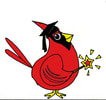|
|
|
|
Disney and Pixar dared to imagine what the world would be like if we didn’t take care of it. In the movie, Wall-E, the world is so overrun with trash that everyone had to flee to space! They all had to live on a huge spaceship and wander around in space. They all lost their ability to walk. Their bones became very soft and they all just flew around on flying chairs all day.
|
Can you imagine a world without trees? Without grass? Without bugs or animals? Where would we live? Where would our oxygen come from? What if we never recycle? What if we never even try to reuse things? Trash would pile up around us. Can you imagine the smell?
|
|
|
|
|
Albert Ketelbey was an English composer, conductor, and pianist. He composed many beautiful pieces of music in the early 1900's. Many of his works reflect his interest in Orientalism, which we studied last week. In music, this is called exoticism. Our listening example today is In a Persian Market. Persia is the old name for modern-day Iran. |

|
|
|
|
In 1896 Ketèlbey took up the post of conductor for a travelling light opera company; his father, who wanted his son to be a composer of serious music, disapproved of what he saw as a lightweight role. After a two-year tour Ketèlbey was appointed as musical director of the Opera Comique Theatre—at age 22, the youngest theatrical conductor in London at the time.
|
|
|
|
|
|
|
